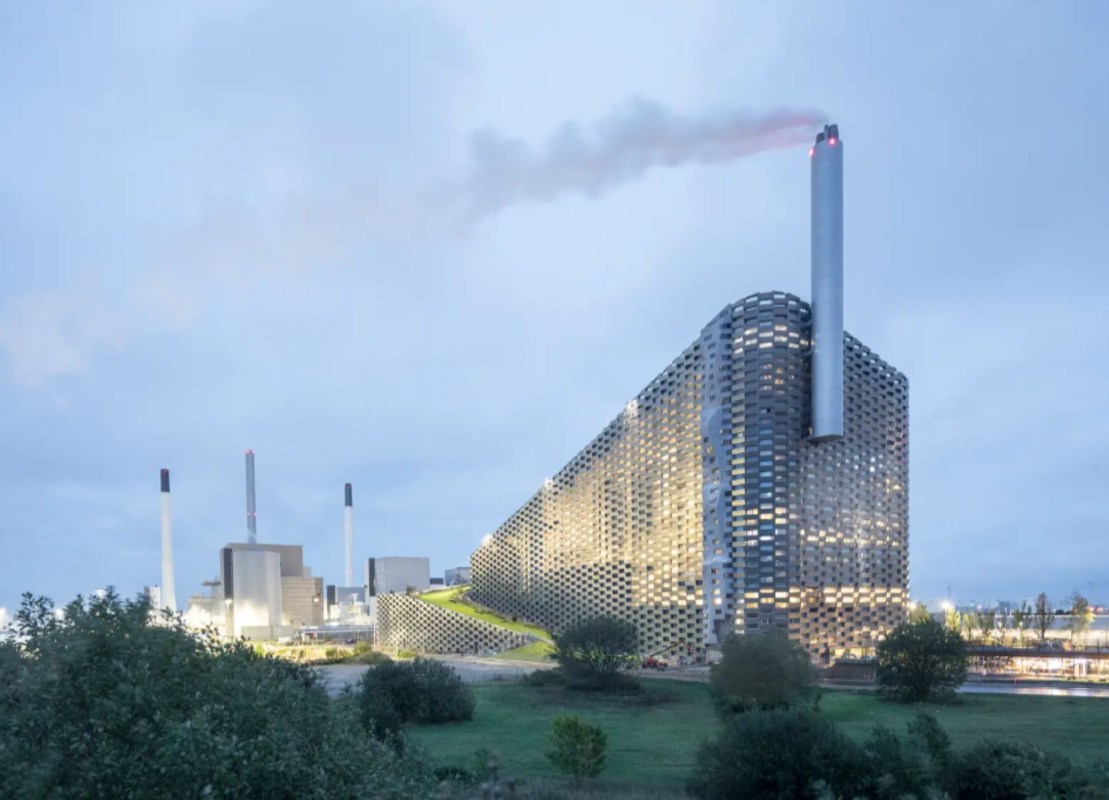In 2019, Copenhagen completed construction on CopenHill, a one-of-a-kind "waste-to-energy" power plant with a beautiful ski slope on its roof, Dezeen reports.
According to the Copenhagen Post, Denmark generates more waste than any other country in the EU — over 1,800 pounds per person yearly. All that trash has to go somewhere, but rather than a recycling plant or landfill, Copenhagen will incinerate it and create clean energy in the process.
Not only does this method get rid of 440,000 tons of garbage each year, but it provides affordable energy for local residents in 150,000 homes.
To do this, Dezeen reports, Copenhagen turned to architecture firm Bjarke Ingels Group, also known as BIG. The firm's design for the "ski plant" won an international competition in 2011, and construction started in 2013 before finishing in 2019.
Bjarke Ingels, the founder of BIG, told Wired in a video showcasing the plant and its skiing that it's "the cleanest waste-to-energy power plant in the world," saying "there are no toxins coming out of the chimney, just some steam" and that it's the "cathedral of waste-to-energy." It should be noted that this steam still contains significant carbon dioxide, as The Earthbound Report has detailed, but Earthbound did not dispute that CopenHill is removing toxins not naturally found in the air and said "district heating from waste has considerably lower CO2 emissions than the gas or coal it replaced."
The building's interior layout includes machinery arranged in order of size, which means the exterior roof creates a consistent slope with a 180-degree turn in the middle. This long ramp has been converted into an artificial ski slope that's open all year round for residents to enjoy.
Visitors to CopenHill can enjoy a rooftop bar and the world's largest artificial climbing wall, according to Dezeen. The roof also holds a garden with a 1,600-foot-long trail for running and hiking.
The vibrant garden helps absorb rainwater, minimizing runoff from the building, and also naturally purifies the air. To get to the rooftop amenities, the building has several elevators and lifts, including a glass elevator that allows passengers to see the waste treatment plant inside. CopenHill's shining exterior is made up of interlaced aluminum blocks and glass panels.
Where does the waste all go? According to Viable Energy, the facility employs a complex, multi-layered filtering and cleaning process to eliminate most pollutants from the plant's flue and water discharges.
"These smoke-scrubbing systems comprise an electric filter, a catalyser, three scrubbers and a dust filter," Viable Energy wrote. "Sequentially removing dust, NOx, HCl, mercury, SO2, water vapour, and any remnants of dust in the smoke. The cleaned smoke is continuously monitored before being released through the chimney."
The solid waste from the burning process, slag (mainly sand, gravel, ash, and metals), comes out to about 17-20% of the waste, per Viable Energy, which explained that even that slag is not treated as pure waste: "They allow the slag to mature for 3-4 months to ensure heavy metals bind to the slag, therefore avoiding leaching. Metals are then removed for recycling. The gravel present in the slag is used in building and construction work. Fly ash recovered from the process sells as a lime substitute. This fly ash by-product is like to cement and is used to recreate the landscape in a disused limestone quarry."
Bjarke Ingels, the founder of BIG, told Dezeen that CopenHill is "a crystal clear example of hedonistic sustainability." He added that "a sustainable city is not only better for the environment — it is also more enjoyable for the lives of its citizens."
Join our free newsletter for weekly updates on the coolest innovations improving our lives and saving our planet.









